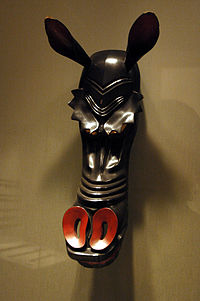Japanese horse forehead
| Japanese horse forehead | |
|---|---|

|
|
| Information | |
| Weapon type: | Protective weapon |
| Designations: | Japanese horse forehead, Bamen |
| Use: | armor |
| Creation time: | around 15th century |
| Region of origin / author: |
Japan , armourers, wood carvers |
| Distribution: | Japan |
| Lists on the subject | |
The Japanese horse forehead ( Japanese 馬 面 , Bamen , German "horse mask ") is a part ( horse forehead ) of the Japanese horse armor .
description
The Japanese horse forehead is made of different materials. There are different versions that are used either for combat or for parade use. The combat versions are usually made of iron (see web link no. 2). It is simple in design and protects the entire front and part of the side of the horse's head. The other versions are mostly made from wood, leather and paper mache . They are used to decorate the horse and the tank and are intended to deter the enemy rather than to protect the horse. Most of the masks are in the shape of a stylized dragon head , which is decorated with lacquer , carvings or metal ( gold or silver-plated). The versions differ in the selected object of the representation and in the decoration.
literature
- Leonid Tarassuk, Claude Blair (Eds.): The complete encyclopedia of arms & weapons. The most comprehensive reference work ever published on arms and armor. Bonanza Books, New York NY 1986, ISBN 978-0-517-48776-1 .
Web links
Individual evidence
- ↑ George Cameron Stone : A Glossary of the Construction, Decoration and Use of Arms and Armor in All Countries and in All Times. With an Introduction by Donald J. LaRocca. Courier Dover Publications, Mineola NY 1999, ISBN 0-486-40726-8 , pp. 170-172.